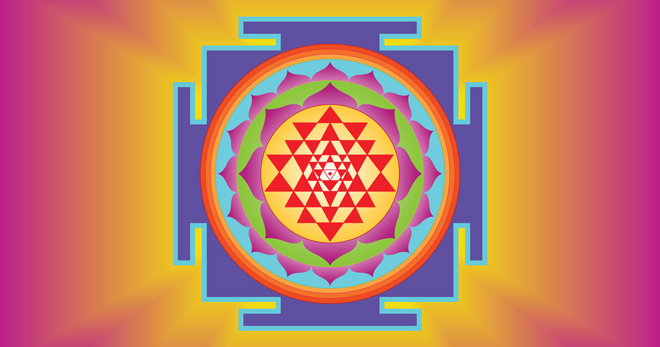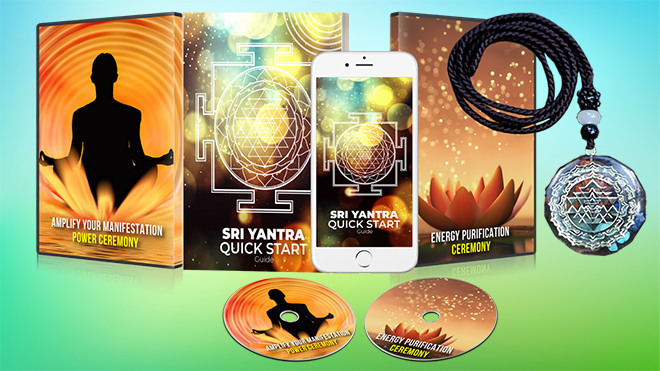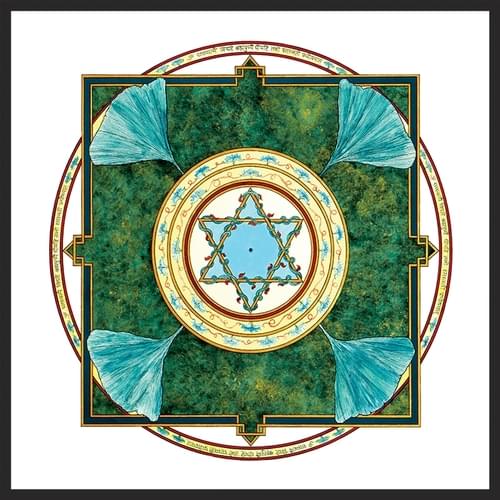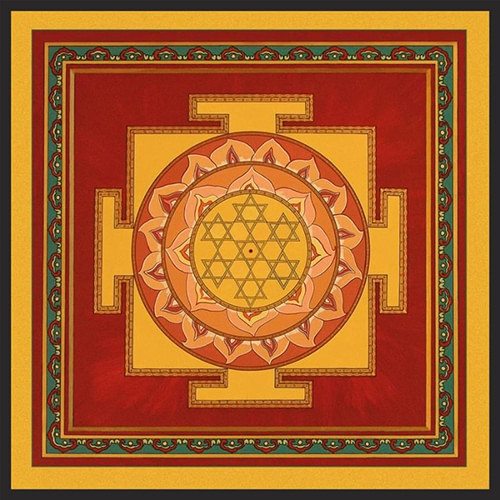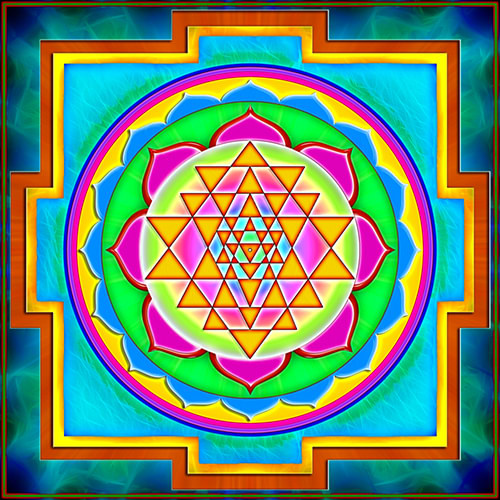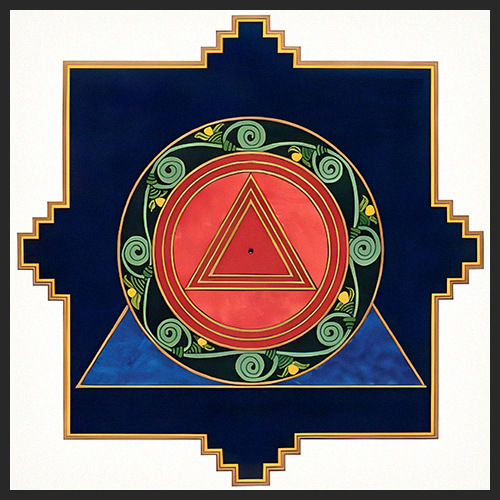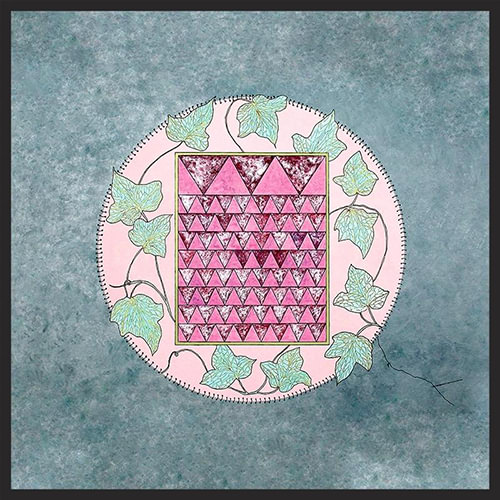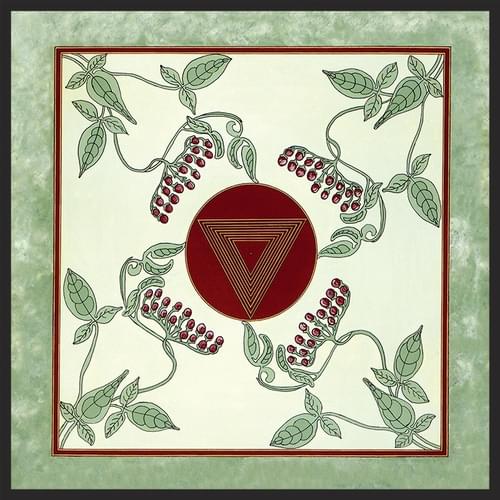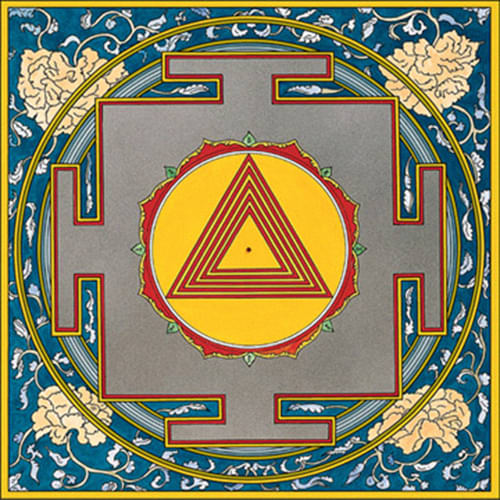Honoring sacred geometric diagrams through contemplation and chanting is said to awaken a divine relationship with life, allowing you to attain spiritual evolution – and bliss.
Yantras are mystical “power diagrams” based on fixed laws of sacred geometry, originally imagined by ancient rishis (seers) of India during profound states of deep meditative awareness.
Honoring yantra is said to awaken a divine relationship with life itself; the inner source of all creation.
Yantra is seen as a representation of the evolution of the macrocosm and microcosm and awakens an evolution of the mind.
Yantras have within them precise and complex Vedic mathematical equations that are known to harmonize and balance both hemispheres of the brain equally when used in conjunction with mantra (words of power).
Mantras are often inscribed within the designs.
As Madhu Khanna explains in Yantra: The Tantric Symbol of Cosmic Unity, yantras are “primordial ‘imprints’ of consciousness – ‘shapes of conception’ that cut across all cultural barriers and are the heritage of all mankind.
[They are] transformers of our psychic energy — such symbols alone allow us to discover a ‘missing part of the whole man’ that makes life joyful, radiant and infinitely meaningful.”
The Origin of Yantra
Yantras are known to the Vedic, Tantric and Buddhist traditions; the Buddhist mandala is the yogic equivalent of the yantra.
In her book Nine Designs for Inner Peace, Sarah Tomlinson explains that tantric teaching is composed of three elements: tantra, the teaching itself; mantra, the sound vibration; and yantra, the visual form through which the deity, planetary energy, tantra and mantra can all be realized.
The Sanskrit root yam means to sustain, hold or support the essence of or energy within an object, element or concept.
Tra comes from trana, meaning liberation from bondage. The liberation (moksha) of yantra also refers to the liberation from the cycle of birth and rebirth.
Yantras exist as monumental Hindu temples and in the ancient 11th-century text Samarangana Sutradhara yantras are referred to as the holding energy within mechanical devices of wooden flying birds, wooden aeroplanes and robot figures.
Yantras can be etched on metal surfaces, sketched on bhojpatra (bark leaves), printed on paper, painted, drawn directly on the ground or engraved on metal or rock crystals.
Madhu Khanna describes yantras as “two-dimensional puthasthana, or pilgrim temples, in which the movement from the profane to the sacred takes place”.
Traditional Uses of Yantra
Yoga (esoteric)
In the tantric tradition of yoga, yantra is seen as the body or physical form of the deity and mantra as the deity or mind.
Yantra increases inner silence and tranquility to reveal the true self.
Sarah Tomlinson says yantras are “containers for spiritual energy” where “the seers found a way to embody within them the celestial forces they saw in the universe. Thus, we can experience the Divine through worship and meditation of this tangible form.”
Jyotish (Vedic astrology)
A Vedic astrologer prescribes a planetary yantra as an upaye (remedy) to pacify or enhance the planetary forces according to your birth chart and ease the karmas in your life.
There are nine astrological (planetary) yantras of the Sun, Moon, Mars, Mercury, Jupiter, Venus, Saturn, Rahu (north lunar node) and Ketu (south lunar node).
Vastu shastra (architectural science of directions)
In vastu shastra, a yantra is used to correct and balance the subtle energies of the home. Where vastu finds a “defect” in the house or plot, a specific yantra can be installed to remedy the problem.
Vastu utilizes yantra, on or above altars in the correct directional quadrants, for purposes such as boosting prosperity, love or success or seeking happiness or health.
The Digdosha Yantra is recommended to revere the deity (Vastu Purusha) that presides over the home.
Architectural yantras are used in ground plans of temples while mandala yantras are engraved on the roof.
Creating Yantras
Harish Johari in Tools for Tantra explains that making yantra is a process where “one moves from concrete reality to abstract truth”.
Tomlinson, in her book, teaches how to create yantras using the precision of the compass, template designs and a quiet attitude of devotion.
She suggests that you work with whatever yantra you’re intuitively drawn to.
Yantras are created from the outside, spiraling inwards in a clockwise direction, to center the self in the bliss of inner stillness.
While immeasurably rewarding, it’s not necessary to create your own yantra. A yantra artist will have incorporated sacred ritual and timings into their work, which are of great benefit to you.
Artist PennyLea Mackie, whose yantras accompany this article, explains her process:
“Prior to starting the piece, I do a mantra practice for the deity I intend to paint. The mantra practice may go on for 40, 80 or 120 days depending on what arises, or what I would like to mitigate. I use my own [Vedic astrology] chart to address it.
In my experience, there is a point in mantra practice during which a two-way communication is entered into between myself and the deity/planetary body, and it is from this place that the deeper understanding is gained into how I am going to depict the parts of the yantra that are open to interpretation (the fields outside of the temple template).
I do not start a piece until I have finished the mantra practice specific to the piece.”
“I set up the yantra during the two weeks of the waxing moon, usually beginning the piece according to the relevant nakshatra [lunar mansion].
Occasionally, I must stop a piece and return to mantra practice to hone my own perceptions or verify internal impressions. When a piece is finished, I wait until the appropriate time to install, during a puja [ritual].”
“Yantra is inevitably the most powerful and collaborative work I have ever entered into.”
Sri Yantra
Sri Yantra is profound and, since all yantras derive from it, it is the mother of all yantras. When the Sri Yantra is three-dimensional, as the Sri Meru Chakra, it represents Mount Meru, the cosmic mountain at the center of the universe.
PennyLea Mackie explains, “The Sri Yantra is not governed by the same rules that most other yantra are. It is a free-standing geometric that can be placed in whichever [color/design] field one chooses. The precision of the diagram is the power of the yantra.”
The Sri Yantra corresponds with the chakras and represents uniting Shakti, the female principle in the form of five downward-pointing triangles, with Shiva, the male principle with four upward triangles.
The nine interlocking triangles form 43 small triangles. It can therefore be extremely difficult to draw, as moving one triangle even slightly requires moving them all.
In vastu, the Sri Yantra is placed in the north or northeast of a room or building. According to vastu-vidya-australia.com, the Sri Yantra can be used to energize food, beverages and other things.
Here the suggestion is to place appropriate items on the yantra and let them stand there for a few minutes or longer to energize the meal.
Inside the Yantra
Yantra design frames your awareness then focuses the mind by moving your attention from the outer symbols to the inner core, mirroring the movement from the outer world of desires to the inner light of consciousness.
Yantras consist of these sacred geometric shapes:
Bhupur
The outline of the yantra. Bhu in Sanskrit means earth, and pura means city. The bhupur is seen as the gates that frame the yantra and open the mind to the higher realms.
Bhupur is a square shape, stabilizing and anchoring the yantra, and represents the four cardinal directions (north, east, south and west).
The corners represent northeast, southeast, southwest and northwest. The bhupur forms the foundation, guiding the eye into the yantra.
Circle
After the bhupur, the circle offers a centering device that shapes the inner gaze. The circle, with no beginning or end, represents oneness, unity, wholeness and completion.
Concentric circles lead to the inner circle or nucleus at the center of the yantra.
Triangles
The upward-facing triangles represent the divine masculine, fiery, energizing aspect of spiritual transformation and the downward-facing triangles represent the divine feminine, cooling, watery aspects of spiritual receptivity, intuitive vision and creativity.
Six-pointed star
Combines the upward- and downward-facing triangles to signify the Shiva (male) and Shakti (female) union.
Lotus petals
Lotus petals are the only aspect of the yantra that are drawn by hand. The lotus symbolizes purity. Eight lotus petals represent the five elements (ether, air, fire, water and earth) and the three aspects of being (intellect, mind and ego).
The Sun yantra has 12 petals and the Moon yantra 16. The lotus is a spiritual symbol of love, beauty, equanimity and joy, the flower rising up through the mud of life.
The curves of the petals bring peace and tranquility to the mind and draw the eye towards the bindu.
Bindu
The bindu is the central dot, the essence of the yantra and of all creation. The bindu represents the void, or pure potential.
All other aspects of the yantra are designed to draw your gaze to this inner place, this tiny sacred circle. It represents Om, the sound of the universe, is unifying and represents the evolution of consciousness.
Yantra Ritual
Your chosen yantra – whether selected intuitively, as part of a deity practice, or given as a Vedic remedy – requires your devotion in order to achieve the desired effect.
Leading Ayurvedic scholar Dr. Robert E. Svoboda says that when you offer your vitality in the form of your attention and life force (prana) to the yantra, you bring the yantra to life.
“If you nourish it, it will nourish you,” he says, for when “properly attended to, a yantra will project its harmony into the spaces of your life, drawing your awareness into the embrace of its primordial depths”.
Through devotion, the soul centers itself. By attending to the yantra regularly, the deity in the yantra is invoked and intimacy with the yantra unfolds.
Yantra practice requires faith, commitment and joyful discipline. Cultivate a daily ritual of communion with your yantra in an environment of serenity and reverence for the practice.
Ideally, place it in the most auspicious Vastu area and direction for your chosen yantra, according to the alignment with the elements, then prepare and clean the area to invoke the prana of the deity.
At the same time each day, sit facing the yantra. Begin by offering lit incense, fresh flowers and a ghee lamp or tealight candle to the yantra. Slow the breath.
Become aware of your natural breathing and perform pranayama (yogic breathing exercises) or continue observing the natural breath.
Be open to invoking the deity. Soften the gaze, offering the mantra specific to the yantra you’re revering through a chanting practice.
Chant with devotion, using mala beads so you can chant in rounds of 108, maintaining your drishti (point of concentration) on the bindu (central point) of the yantra.
Let go of all judgements or expectations and center yourself within the practice.
Once you finish chanting, stay in a meditative state of devotion, allowing the deity or planetary relationship to cultivate within you.
Close your eyes and hold the image of the yantra as you focus back on your natural breath.
Rest your awareness in your heart space, in the center of your chest, for at least a few minutes.
Give thanks for the possibilities to move toward higher awareness, cultivated through yantra practice, then seal the practice in prayer pose before gently transitioning into your day.
Sacred geometry alters and transforms the patterns of your mind. There are places you can purchase yantras, or you can draw, color or paint your own from template designs.
The experience is yours to be had and can accelerate all other spiritual work for your individual awakening and supreme joy. Become the deity within the yantra; transform.
»» Create Amazing Sacred Geometry Art with OmniGeometry Software ««
Selected Yantras
Some of these beautiful yantras have been illustrated by PennyLea Mackie, who also wrote the accompanying descriptions.
Saraswati Yantra
Another face of the Divine Mother, Saraswati rules the realm of beauty, art and sound (at its highest potential).
She also rules learning (intelligence and thought), and is the consort/Shakti (feminine) element to Brahma (the masculine aspect of creation).
Surya Yantra
Use of a Surya Yantra opens direct dialogue to the masculine entity of the sun. As a planetary yantra, the effects to be gained are individual and best assessed through Vedic astrology.
Use of a Surya Yantra with Gayatri mantra (a revered Vedic chant) is a profoundly clarifying practice.
Sri Yantra
With four upward-pointing triangles (masculine) and five downward-pointing triangles (feminine), the Sri Yantra represents the dynamic union of the feminine and masculine.
Kali Yantra
Kali represents a feminine aspect of Divine Mother, who aids in bringing the death of the ego as the illusory self-centered view of reality.
This Kali Yantra is in the “resting” position. When not in use as a working yantra, it is turned so the triangle is upward-pointing to bring a pause in ongoing effects of the actions initiated through use of the yantra.
Shakti Yantra
All 10 aspects of Divine Mother (the Mahavidyas) are represented in this dynamic yantra, which visually includes the union of feminine and masculine through the interplay of downward- as well as upward-pointing triangles.
Tripura Bhairavi Yantra
Tripura Bhairavi is one face of the 10 Faces of Mother Divine. She is fierce (burning off the impure) as well as devotional (saving those who enter into relationship with her from suffering and negative karmic pressures).
Shiva Yantra
In a triune (three-in-one) approach to existence (creation, maintenance, destruction), Shiva is the masculine aspect that represents the dissolution stage (of mind, matter), clearing the field for recreation (Brahma).
 Expert eBooks Courses | Online-eBook-Download.com Latest digital books and courses, Tips & Tricks, How-to guides, free ebooks, software discounts, coupons & much MORE… Instant Download
Expert eBooks Courses | Online-eBook-Download.com Latest digital books and courses, Tips & Tricks, How-to guides, free ebooks, software discounts, coupons & much MORE… Instant Download

